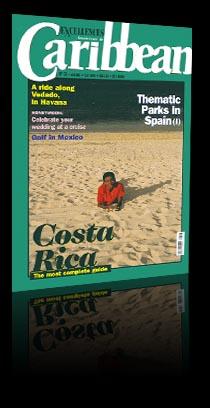Vedado. The most spacious borough of Havana
El Vedado is Havana's economic modern center, in any other city of the area, people rush but here Cubans keep a quiet pace. To have a ride along El Vedado is a pleasant experience and an opportunity to know the idiosyncrasy of such an extraordinary people.
Vedado in Spanish means "forbidden," thus something was prohibited for some time along this area surrounded by a forest, which in colonial times was an inaccessible site. The opening of roads and trails was entirely forbidden, thus preventing a possible corsairs’ attack. Let's assume that El Vedado starts at Malecón (Havana's water front), i.e. at the Malecón section that comprises Vedado because in Havana everything starts and ends here at this lengthy sea ride and at Christopher Columbus Cemetery. Most daylight activities and nightlife as well are focused on this borough. Restaurants, stores, discotheques, ballrooms, ministries, airlines offices...everything is found there, along the first five sections, comprising the well-known La Rampa street on 23rd Avenue. A walk along 23rd Avenue starting from Malecón upward, allows you to experiment the vivid life of this street. On the right, the National Hotel, a part of Havana's history. Since its inauguration on 1930 New Years' eve, dozens of artists and politicians have stayed in this hotel. The National Hotel was built on a terrace of some 10 meters of altitude that in colonial times was a strategic military enclave. Today, when one has a ride along its gardens facing the Caribbean Sea, scaring old cannons are found as decorative elements. These gardens are visited by Cubans who want to enjoy a nice place to have a shot, newly married also frequent the place to keep the memory of this day on a picture. Girls who arrive at the age of fifteen, wear a long sophisticated dress, hired for this occasion and likewise attend the site also to preserve this memory on a photo. It is a tradition in Cuba that girls celebrate their fifteen anniversary with a party and wearing a long dress for photo sections. If we continue down Malecón, Maine Monument can be immediately found, along this area very popular fast food-sale points are located where visitors and Cubans eat and drink at a reasonable cost. You can also find at Vedado, people hanging around who like to visit traditional small markets. This borough has two markets: one large and well-stocked full of crafts, old books with leather cover, paintings and so forth, just some steps down the abovementioned monument between the streets E and F there is another smaller market on 23rd Avenue. Let's go back again to 23rd Avenue, near the National Hotel we reach the Habana Libre Hotel. Twenty-five floors made up this well-known Cuban hotel, built 40 years ago. Now it exhibits a new-brand look thanks to a general reparation. This modern facility provides good comfort and is also a witness of Havana's history. The view that can be admired from the highest stories are the most spectacular ever seen in any other city of the world. Dawn and twilight make you feel in a dream. The crossing point of several streets meeting at 23rd avenue near this hotel, is a key point in the city. On a corner stands Habana Libre Hotel, exhibiting one of the most photographed façades of Cuba. On another corner, opposite the hotel, we found Yara cinema. Opposite the cinema, we can always see a long queue all day long until 11 p.m. made up of people from all ages, with the only aim of having an ice cream in the famous Coppelia ice-cream cafetería, far more famous after the projection of the film "Strawberry and Chocolate". While waiting on the queue for four or five hours, people chat with anyone that is available until the supreme moment arrives, that of sitting down along the section surrounded by splendid vegetation and under the shade of these centennial trees they taste scoops of different flavors. If we go from this corner up, we are setting out for the University, its large grand staircase is impressive as well as its façade of a classic Greek-Roman style. Napoleon Museum is located next to the University on Calle San Miguel No.1159, phone: 791112, open from Tuesday to Saturday and Sunday mornings. Our tour continues up to the large Revolution Square (Plaza de la Revolución), a site of so many mass patriotic rallies in the last decades where the heart of the homeland beats, according to schools’ textbooks. José Martí Monument is located in the very center where a giant obelisk made of marble from the Isle of Youth is erected behind the 18-meter statue of the National Hero of Cuba. The memorial building houses a museum with an interesting display devoted to José Martí and a lift take visitors to the highest floor of the obelisk where a lookout is found and Havana city can be seen at 360º as a bird's view. When visitors leave they are provided with a certificate whose content states that they have been in the highest point of the city of 142m high. José Martí Museum closes very late from Monday to Tuesday. The fee to see the lookout costs US$5.00. Modern buildings housing official offices surround the Square: the Palace of the Revolution, the National Theater, the Ministry of the Armed Forces , the National Library and others. On one of the façades a large silhouette of Che Guevara, made of iron can be seen with the slogan "Hasta la Victoria Siempre!" , another indispensable picture to be taken. We can visit Columbus Cemetery, a white panorama because of the tumulus, sculptures and marble gravestones, its clean and straight streets: an urban orderly layout in the midst of the dead’s silence.






























































